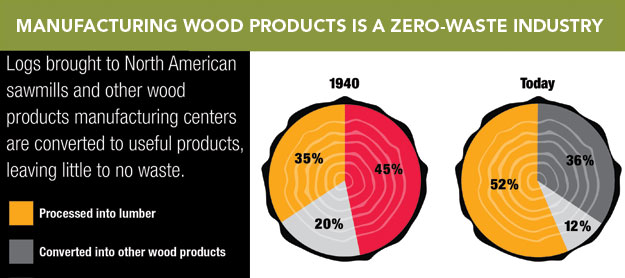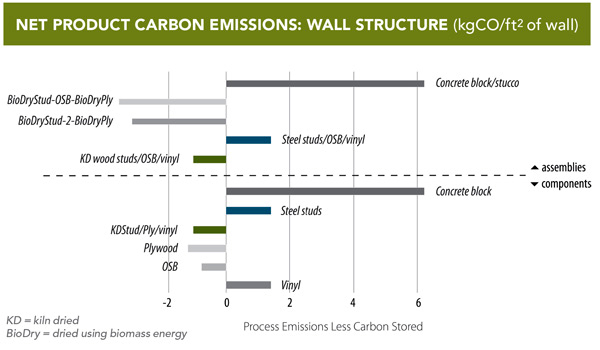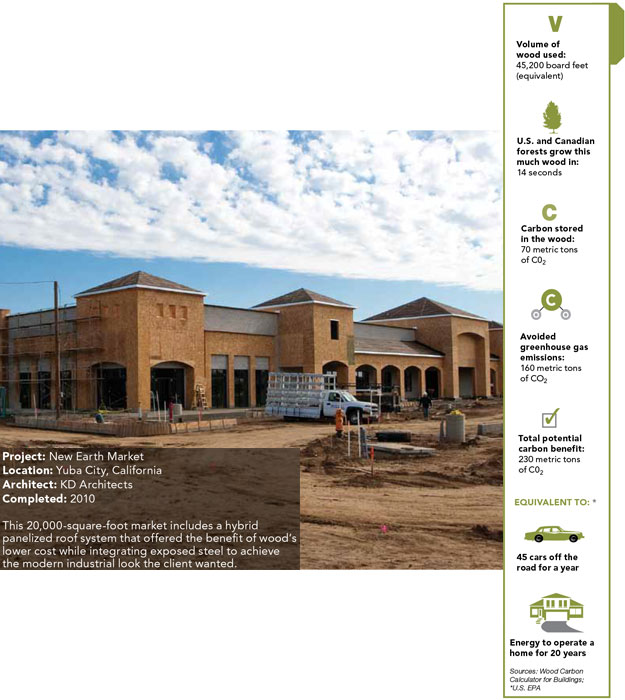Evaluating the Carbon Footprint of Wood Buildings
Toward Net Zero Energy
While it is fairly well known that wood products sequester carbon and typically require less energy to manufacture than other building materials, their performance related to operational energy efficiency is often overlooked.
From a thermal perspective, wood-frame building enclosures are inherently more efficient than other materials—because of the insulating qualities of the wood structural elements, including studs, columns, beams, and floors, and because wood stud walls are easy to insulate. Options also exist for insulating wood-frame buildings that aren't available for other construction types. For example, while requirements for lighting systems or mechanical systems do not change based on structural material, wood's versatility related to building envelope configuration gives designers more insulation flexibility.

Source: Utilization of Harvested Wood by the North American Forest Products Industry, Dovetail Partners, Inc.
New wood building systems have also been developed that offer greater air tightness, less conductivity, and more thermal mass, including prefabricated systems that contribute to the low energy requirements of Passive House and net-zero designs. Passive House is an approach that uses the building's architecture to leverage natural energy sources, minimize energy consumption, and improve thermal comfort. Popular in Europe and gaining ground in North America, passive buildings rely heavily on high-performing building envelope assemblies and passive solar energy. Wood is an attractive material for passive design because of how it combines thermal mass with a number of performance merits, including water resistance, structural integrity, and finish quality. Although there are several types of net-zero-energy buildings, the term generally refers to residential or commercial buildings that are extremely energy efficient and produce the small amount of energy they do need via on-site renewable sources. Buildings may draw energy from the grid at night and return energy generated from renewable sources back to the grid during the day. The U.S. Department of Environment has a goal that all new commercial buildings be net zero energy by 2025.

Source: Lippke & Edmonds, 2009, Building with Wood – Proactive Climate Protection, Dovetail Partners Inc.
When wood products are manufactured, low energy consumption (and very low fossil fuel consumption) results in much lower greenhouse gas emissions than when alternative materials are produced. For wood products and wall assemblies, carbon emissions (or CO2 equivalent emissions) are typically less than zero, meaning that more carbon is contained within the wood itself than is released into the atmosphere in the course of its manufacture.
Wood for a Sustainable Future
“Increasing the global forest land base and increasing the capacity of each forest, while using them as a sustainable supply of wood for building materials and fuel to offset the need for other energy-intensive materials and fossil fuels represents an important carbon mitigation option over the long term.”
—UN Food and
Agriculture Organization,
2010 report
Perhaps it is not surprising that wood, one of the oldest and most natural building materials on earth, would have a more positive environmental impact than materials that are highly energy intensive. But only recently has the analysis of products used in buildings become sophisticated enough to study and measure that impact scientifically. Actively managed forests store large amounts of carbon. Wood products are manufactured from the renewable, natural raw material that results from the forest cycle. They are adaptable and reusable, and they continue to store carbon throughout their lifetimes. These characteristics make wood an excellent, low-carbon alternative to many of the materials now widely used in construction and consumer goods. Just as wood has been a desirable building material since the distant past, it will make an essential contribution to a sustainable future.

Photo by Jerry Gregg, Hilbers, Inc.
NOTE: The carbon calculations throughout this CEU were estimated using the Wood Carbon Calculator for Buildings [www.woodworks.org], based on research by Sarthre, R. and J. O'Connor, 2010, A Synthesis of Research on Wood
Endnotes
- Stella case study, 2013, http://www.woodworks.org/wp-content/uploads/Stella-CaseStudy-WEB.pdf
- U.S. Environmental Protection Agency, Greenhouse Gas Equivalencies Calculator, http://www.epa.gov/cleanenergy/energy-resources/calculator.html
- U.S. WoodWorks, Wood Carbon Calculator for Buildings, http://woodworks.org/design-tools/online-calculators/
- NC State University College of Agriculture & Life Sciences, http://www.ncsu.edu/project/treesofstrength/treefact.htm
- Bullitt Center case study, 2013, http://www.woodworks.org/wp-content/uploads/CS-Bullitt.pdf
- Building with Wood – Proactive Climate Protection, Dovetail Partners, Inc., 2015
- USDA Forest Service, http://www.fs.fed.us/research/sustain/national-report.php
- American Forest & Paper Association, http://www.afandpa.org/our-industry/fun-facts
- Impact of the global forest industry on atmospheric greenhouse gases, Food and Agriculture Organization of the United Nations, 2010, http://www.fao.org/docrep/012/i1580e/i1580e00.pdf
- A Synthesis of Research on Wood Products and Greenhouse Gas Impacts, FPInnovations, 2010
- Chadwick Dearing Oliver, Nedal T. Nassar, Bruce R. Lippke & James B. McCarter, Carbon, Fossil Fuel, and Biodiversity Mitigation With Wood and Forests, Journal of Sustainable Forestry, 33:3, 248-275, 2014
- A Synthesis of Research on Wood Products and Greenhouse Gas Impacts, FPInnovations, 2010
- Werner, F. and Richter, K., Wooden building products in comparative LCA: A literature review; International Journal of Life Cycle Assessment, 12(7):470-479, 2007
- Arena Stage case study, U.S. WoodWorks, 2011, http://www.woodworks.org/wp-content/uploads/CS-Arena-stage.pdf
- Utilization of Harvested Wood by the North American Forest Products Industry, Dovetail Partners Inc., 2012
- Survey on actual service lives for North American buildings, O'Connor, J., FPInnovations, 2004
 |
The reThink Wood initiative is a coalition of interests representing North America’s wood products industry and related stakeholders. The coalition shares a passion for wood products and the forests they come from. Innovative new technologies and building systems have enabled longer wood spans, taller walls, and higher buildings, and continue to expand the possibilities for wood use in construction. www.rethinkwood.com |








